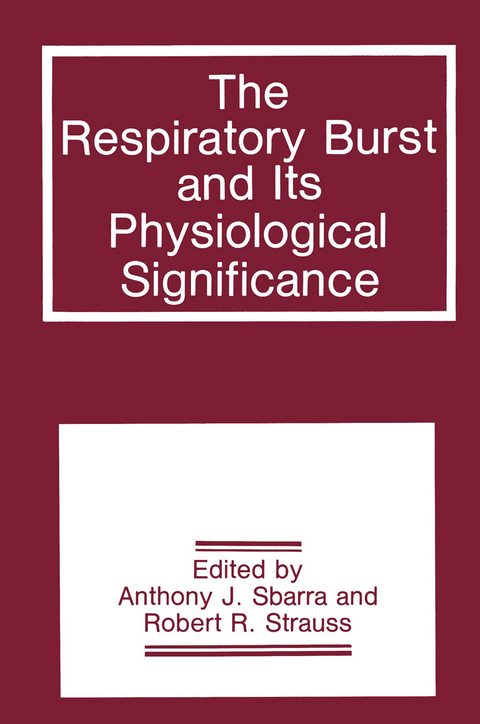
The Respiratory Burst and Its Physiological Significance
Springer-Verlag New York Inc.
978-1-4684-5498-7 (ISBN)
When phagocytes are exposed to a number of different stimuli, they undergo dra matic changes in the way they process oxygen. Oxygen uptake increases markedly, frequently more than 50-fold; the phagocytes begin to produce large quantities of superoxide and hydrogen peroxide; and they immediately begin to metabolize large amounts of glucose by way of the hexose monophosphate shunt. This series of changes has become known as the respiratory burst. It was first believed that the major function of this respiratory burst was to generate powerful antibacterial agents by the partial reduction of oxygen. It is becoming apparent that the respiratory burst has much wider application, and its physiological function in many different biolog ical areas is clear. In this volume, we have attempted to bring together the work of experts who have published extensively on the involvement of the respiratory burst in different physiological functions. In the first three chapters, Dr. Borregaard and Dr. Berton and co-workers and Dr. Roos and co-workers bring together what is known about the respiratory burst. They present up-to-date versions of the biochemical and metabolic activities associ ated with the burst. In Chapter 4, Dr. Styrt and Dr. Klempner discuss the respiratory burst as it affects cellular ion homeostasis. Dr. Cohen and Dr. Britigan (Chapter 5) present some interesting data on the competition between the respiratory burst and bacteria for oxygen. Dr. Dobrina and Dr.
1. The Respiratory Burst: An Overview.- 2. The Respiratory Burst of Phagocytes.- 3. The Respiratory Burst and the NADPH Oxidase of Phagocytic Leukocytes.- 4. The Respiratory Burst and Cellular Ion Homeostasis.- 5. An Expanded View of the Phagocytic Respiratory Burst: Bacterial Competition for Oxygen and Its Stimulation by Host Factor(s).- 6. The Respiratory Burst and Endothelial Cells.- 7. The Respiratory Burst of Eosinophils.- 8. The Respiratory Burst and Lymphocyte Function.- 9. Modulation of the Respiratory Burst by Naturally Occurring Substances.- 10. Oxidants Formed by the Respiratory Burst: Their Physiological Role and Their Involvement in the Oxidative Metabolism and Activation of Drugs, Carcinogens, and Xenobiotics.- 11. Drug-Induced Agranulocytosis and Other Effects Mediated by Peroxidases during the Respiratory Burst.- 12. The Respiratory Burst and the Metabolism of Drugs.- 13. The Respiratory Burst and Carcinogenesis.- 14. The Respiratory Burst and Mechanisms of Oxygen Radical-Mediated Tissue Injury.- 15. The Respiratory Burst of Neutrophilic Granulocytes and Its Influence on Infected Tissues: Indirect Consequences.- 16. The Respiratory Burst and Psoriasis.- 17. The Respiratory Burst and Diabetes Mellitus.- 18. The Respiratory Burst of Fertilization.- 19. The Respiratory Burst and Atherosclerosis.- 20. The Respiratory Burst and Aging.- 21. The Respiratory Burst and the Onset of Human Labor, Preterm Labor, and Premature Rupture of the Membranes.- 22. Tuftsin: Biochemical and Biological Aspects.
| Zusatzinfo | 500 p. |
|---|---|
| Verlagsort | New York, NY |
| Sprache | englisch |
| Maße | 152 x 229 mm |
| Themenwelt | Sachbuch/Ratgeber ► Natur / Technik ► Garten |
| Medizin / Pharmazie ► Medizinische Fachgebiete ► Mikrobiologie / Infektologie / Reisemedizin | |
| Naturwissenschaften ► Biologie ► Biochemie | |
| Naturwissenschaften ► Biologie ► Botanik | |
| Naturwissenschaften ► Biologie ► Mikrobiologie / Immunologie | |
| Naturwissenschaften ► Biologie ► Ökologie / Naturschutz | |
| Naturwissenschaften ► Biologie ► Zoologie | |
| ISBN-10 | 1-4684-5498-6 / 1468454986 |
| ISBN-13 | 978-1-4684-5498-7 / 9781468454987 |
| Zustand | Neuware |
| Haben Sie eine Frage zum Produkt? |
aus dem Bereich


